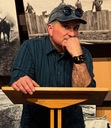Phil Giunta's Blog, page 45
March 7, 2018
About This Writing Stuff…
This week, Peter Selgin offers ideas on dramatizing the routine in your story, writer pal Donna Galanti shines light on how to build your author persona, and Sue Weems suggests ways to combat multitasking that will improve your writing and save your sanity.
Despite arguments to the contrary, author blogging is not dead according to Anne R. Allen, and she provides eight solid reasons why.
Struggling to avoid hackneyed methods to describe your first-person POV character? Laura DiSilverio has some advice for you while James Scott Bell wants to pump you up—or at least your prose—by showing you how to immerse your reader in both action and emotion.
All that and a little more… Enjoy!
Four Ways to Create Your Author Persona by Donna Galanti
How to Make the Best Use of “Routine” Events in Your Fiction by Peter Selgin via Jane Friedman
‘The ebook is a stupid product: no creativity, no enhancement,’ says the Hachette Group CEO by Harsimran Gill
‘Laughably bad’: Terry Goodkind Apologises After Insulting Cover of His Own Book by Sian Cain
Get Some Blood Pumping in Your Prose by James Scott Bell
Why Multitasking is Killing Your Writing by Sue Weems
How the Internet Archive Infringed My Copyrights and Then (Kind of) Blew Me Off by Victoria Strauss
8 Reasons to Start an Author Blog by Anne R. Allen
6 Tips for Describing a First Person POV Character by Laura DiSilverio
Facebook’s Algorithm has Wiped Out a Once Flourishing Digital Publisher by Mike Shields
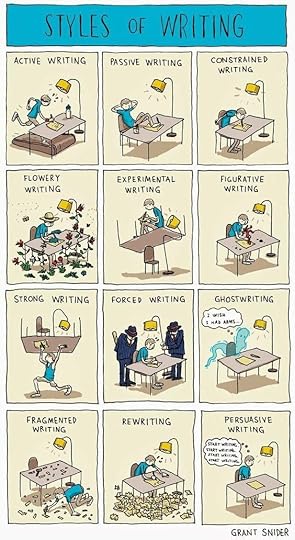
March 1, 2018
The Plague is Coming!
Received an update this morning from Delaware-based Smart Rhino Publications about their upcoming horror anthology, A PLAGUE OF SHADOWS. This collection will include my paranormal tale, “Bottom of the Hour” about a young man, cursed with the ability to hear death approaching, who is talked into buying a haunted Camaro.
From Smart Rhino Publications Executive Editor Weldon Burge:
We’re now pulling together A PLAGUE OF SHADOWS: A WRITTEN REMAINS ANTHOLOGY. Smart Rhino Publications collaborated with the Written Remains Writers Guild to publish SOMEONE WICKED a few years ago. PLAGUE is our second collaboration. We intend to have a Kickstarter campaign to defray some of the costs.
Here are the current writers in the TOC:
Jane Miller
Maria Masington
Billie Sue Mosiman
Carson Buckingham
Phil Giunta
Greg Smith
Graham Masterton
Patrick Derrickson
Jeff Strand
JM Joanne M Reinbold
Jacob Jones-Goldstein
Gail Husch
Jasper E. Bark
Shannon Connor Winward
Jeff Markowitz
Patrick Conlon
Jennifer Loring
Justynn Tyme
Weldon Burge
Stephanie M. Wytovich
As with SOMEONE WICKED, we’re juxtaposing WR members with guest writers–and the content of the anthology so far is astounding!
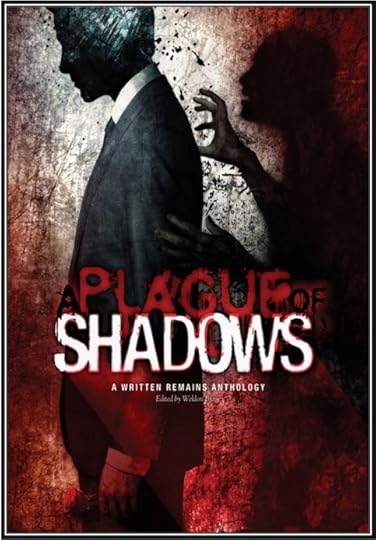
February 23, 2018
About This Writing Stuff…
This week, Ava Jae looks at simple POV mistakes to avoid, while Jo Eberhart explains the difference between foreshadowing and callbacks and how each can be used in your story.
Over at the Kill Zone, James Scott Bell calls out writing flubs that throw readers out of stories, Mythcreant writer Oren Ashkenazi offers tips on creating immersive fantasy settings, and Susan Perabo expounds on a method for developing characters with background and experiences entirely different from our own.
All that and a little more. Enjoy!
10 Books Every Leader Should Read to Be Successful by Deep Patel
Amazon Author Insights – Understand Your Formatting Options by Honorée Corder
Is 99¢ Too Cheap a Price for Your Book? by Dana Isaacson
Different Kinds of POV Slips and How to Avoid Them by Ava Jae
Foreshadowing vs. Callbacks by Jo Eberhardt
Creating Fully Developed Fictional Characters (That Are Not Secretly You) by Susan Perabo
Stuff That Takes Readers Out of a Story by James Scott Bell
Six Tips to Make Your Fantasy Setting More Immersive by Oren Ashkenazi
The New Face of Vanity Anthologies: Z Publishing House and Appelley Publishing by Victoria Strauss
Agatha Christie was Investigated by MI5 Over Bletchley Park Mystery by Richard Norton-Taylor
February 17, 2018
Book Review: 50 Short Science Fiction Tales edited by Isaac Asimov and Groff Conklin
Typically when I review an anthology, I will enumerate my favorite stories and briefly provide a blurb about each one. In the case of 50 Short Science Fiction Tales—edited by the legendary Isaac Asimov and renowned anthologist Groff Conklin—that would be a daunting and tedious task.
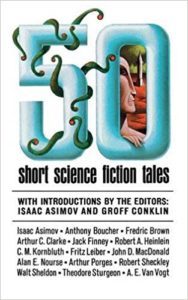 Suffice it to say that like any collection, certain stories are better than others and this one is no exception. However, the majority of the entries are some combination of witty, engaging, chilling, thought provoking, or amusing. Of course, how could it be otherwise with such luminaries as Isaac Asimov, Arthur C. Clarke, Robert Heinlein, C.M. Kornbluth, Robert Sheckley, Theodore Sturgeon, and A.E. Van Vogt, just to name a few.
Suffice it to say that like any collection, certain stories are better than others and this one is no exception. However, the majority of the entries are some combination of witty, engaging, chilling, thought provoking, or amusing. Of course, how could it be otherwise with such luminaries as Isaac Asimov, Arthur C. Clarke, Robert Heinlein, C.M. Kornbluth, Robert Sheckley, Theodore Sturgeon, and A.E. Van Vogt, just to name a few.
Most of the stories here are no more than 3,000 words. The book opens with a short poem by Poul Anderson and closes with six haiku written by his wife, Karen. I highly recommend this anthology both to aficionados of the golden age of SF or as an introduction to many of the top talents of the time.
February 15, 2018
About This Writing Stuff…
This week, James Curnow ponders the detrimental effect of sequels on the original material. Paula Meiner covers the pros and cons of beta readers while Sophie Hannah questions the concept behind the Staunch prize for thrillers that avoid violence against women.
James Scott Bell, Tracy Hahn-Burkett, and Steven James weigh in on the related topics of burnout, frustration, and stressing yourself out over meeting your writing goals. Bottom line: Challenge yourself without killing yourself.
All that and a little more. Enjoy!
12 Books That Destroyed and Rebuilt My Mind by Jordan Bates
Why Good Sequels are Bad Sequels: Blade Runner 2049 and the Building of Worlds by James Curnow
A Short History of South Asian Speculative Fiction: Part I by Mimi Mondal
The Pros and Cons of Beta Readers by Paula Munier
Avoiding Burnout with Strategic Breaks by James Scott Bell
What to Do When Your Creativity Hits the Wall by Tracy Hahn-Burkett
From 2000 to 300—Why You’re Writing Too Much by Steven James
Prize Launched for Thrillers That Avoid Sexual Violence Against Women by Alison Flood
A Prize for Thrillers With No Violence Against Women? That’s Not Progressive by Sophie Hannah
Do Your Characters Talk Too Much? When to Use Indirect Dialogue by Anne R. Allen
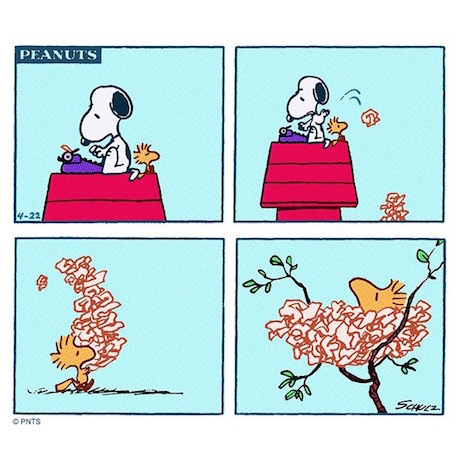
February 12, 2018
Book Review: Nightfall and Other Stories by Isaac Asimov
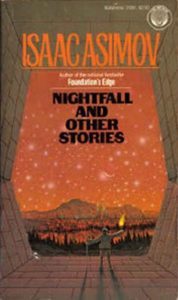 Twenty stories comprise this collection of what Asimov himself considered his finest work up to 1969. These tales had been originally published in such periodicals as Astounding Science Fiction, Galaxy Science Fiction, Playboy, Star Science Fiction Stories, Scientific American, and more.
Twenty stories comprise this collection of what Asimov himself considered his finest work up to 1969. These tales had been originally published in such periodicals as Astounding Science Fiction, Galaxy Science Fiction, Playboy, Star Science Fiction Stories, Scientific American, and more.
My favorites include:
An advanced civilization panics when five of their suns have set and the sixth is about to be eclipsed, casting their part of the world into “Nightfall” for the first time in generations. Arguably one of Asimov’s best stories of all time.
To the chagrin of her police officer husband Drake, biologist Rose Smollett volunteers to play “Hostess” to an alien scientist from Hawkins’ Planet. It isn’t long before Drake discovers that the alien has ulterior motives, one that could ignite an interstellar war.
When a physicist named Ralson threatens to commit suicide, he is placed under psychiatric care by the Atomic Energy Commission with the caveat that any therapy must be quick. Ralson has the uncanny ability to rapidly solve almost any scientific problem and the A.E.C. thinks that he can create a force field to repel atomic energy. Of course, they want it done yesterday in “Breeds There a Man…?”
A merchant ship from Earth is captured by an alien enemy known as the Kloro. While the humans aboard are antagonistic toward one another, one man named Mullen rises above by volunteering for a dangerous mission. If he is successful, the other passengers will be able to retake the ship. Mullen must suit up and walk the exterior hull of the craft in magnetic boots, but to get there, he’ll have to be ejected from the corpse chute, otherwise known as the “C-Chute.”
Jeff Stock and Dick Altmayer have been friends for decades, during which Jeff has risen through the military ranks and Dick, a conscientious objector, has been arrested multiple times for draft dodging, terrorism, and treason. Yet, in the end, it’s possible that both men are heroes “In A Good Cause—”.
After discussing what might have happened if they’d each made different choices in life, a married couple named Norman and Livvy encounter a eccentric old man on a train who presents them with a mirror that allows then to ask “What If—” and see the results play out. Will Norman and Livvy’s love survive this test?
A con-man named Gellhorn visits a mechanic named Jake who restores old automatic cars and allows them to roam free on his farm. Gellhorn tries to make an offer that Jake cannot refuse—take parts from Jake’s restores and use them to refurbish old vehicles to sell at new car prices. After Jake turns him away, Gellhorn returns with muscle, but they are no match for “Sally“, Matthew, and the rest of the cars with minds of their own…
“It’s Such a Beautiful Day” when young Richard decides to walk to school after the teleportation “Door” in his home malfunctions. The problem is that in this perfect utopia, no one ever walks outside when you can simply use the Door system to teleport anywhere in the world. When Richard begins to form a habit of strolling outdoors at every opportunity, a psychiatrist is called in, but in the end, who ends up being the true counselor?
An elderly sociologist travels to the human asteroid colony of Elsevere to study their caste society. Upon arrival, he suspects something is wrong and is proven correct upon learning that the head of sanitation, who lives well and is highly compensated, is nevertheless treated like a second class citizen. No one else on Elsevere will even speak to Ragusnik or his family. As a result, Ragusnik has stopped work and in the end, it’s up to Lamorak to be the “Strikebreaker.”
February 11, 2018
After Action Report: Farpoint 25
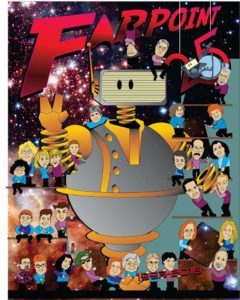 Farpoint 25 Program Book Cover by Todd Brugmans featuring caricatures of the entire Farpoint Convention Committee
Farpoint 25 Program Book Cover by Todd Brugmans featuring caricatures of the entire Farpoint Convention CommitteeJust returned home from the 25th annual Farpoint SF convention in Hunt Valley, MD and I am proud to say that I’ve been attending since day one waaaaay back in 1993 when I first met the convention’s co-founder and fellow writer, Steven H. Wilson.
We struck up a friendship that has only become stronger over the years since both of my novels and our Middle of Eternity anthology series were all published under Steve’s imprint, Firebringer Press. In fact, we have more books coming soon as we discussed during our Saturday morning panel along with fellow Firebringer writers Susanna Reilly, Michael Critzer, Diane Baron, Daniel Patrick (Renfield) Corcoran, and our layout specialist, Ethan Wilson.
In its early days, Farpoint sponsored a short story contest. My first submission was in 1995 when I entered a Star Trek story and took second place after a tie-breaker. The contest faded away through the decades until this year, when author track manager Steve Lesnik resurrected it. This time around, entries had to be 2,500 words or less and be based on a common photograph taken by Steve during his trip to Europe. No details about the origin of the photo were divulged, but I happened to recognize it.
I am ecstatic to report that, once again after a tie-breaker, I took second place for my post-WWII short story, “All That Matters is What You Believe.”
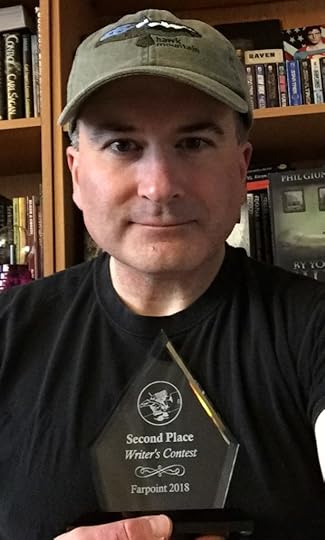
Now that the contest is over, I can dish the details. Click here to read the stories from the contest! Not sure how long the link will remain up. There were 13 entries total. Mine is #12: “All That Matters Is What You Believe.” First place winner was #4: “Splitting Arrows” by Eric Bakutis and Third Place was #6: “Hillfolk” by Aaron Rosenberg. All three of our stories will be printed in next year’s Farpoint program book.
As for the rest of the convention, I had a great time reuniting with many friends, some of whom I only get to see twice a year at the Maryland conventions (Farpoint and Shore Leave). Many of these friends are my fellow author guests such as the aforementioned Firebringer Press writers, but also Aaron Rosenberg, Russ Colchamiro, David Mack, Heather Hutsell, Diane Baron, Howard Weinstein, Keith DeCandido, Allyn Gibson, and many more!
The celebrity guests included Matt Frewer (Max Headroom, Timeless, Orphan Black, Watchmen, Eureka, the list goes on), Nana Visitor (most known to SF fans as Kira from Star Trek: Deep Space Nine), Nora McLellan (Killjoys), and popular SF and Star Wars author, Timothy Zahn.
While I’ve met Ms. Visitor at many cons in the past, this was my first time meeting Matt Frewer and it was a delight. He was funny, gracious, and kind to the fans. A truly positive experience.
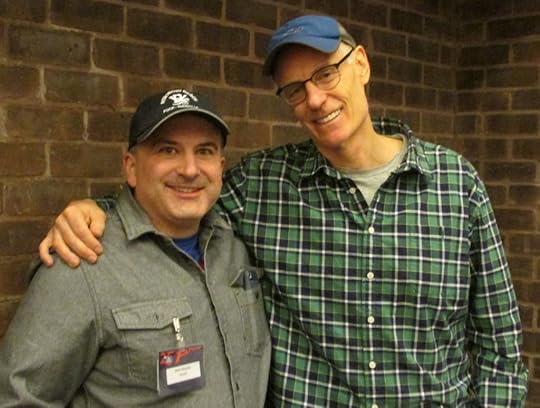
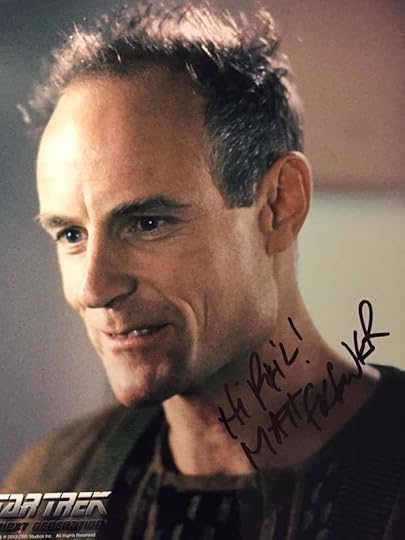
On Friday night, Farpoint hosted the traditional book fair for all of the published author guests. It was a great opportunity for me to catch up with many of my fellow word slingers. Below are just some of my colleague at Firebringer Press (from left to right: Steven H Wilson is chatting with a friend while Michael Critzer and Susanna Reilly smile for the camera).
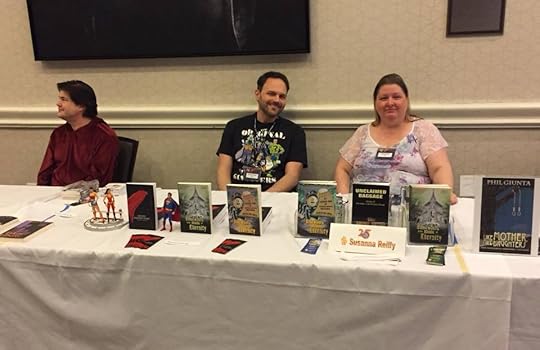
Writer pal Heather Hutsell (below) was one of a few authors who had book premieres at Farpoint 25.
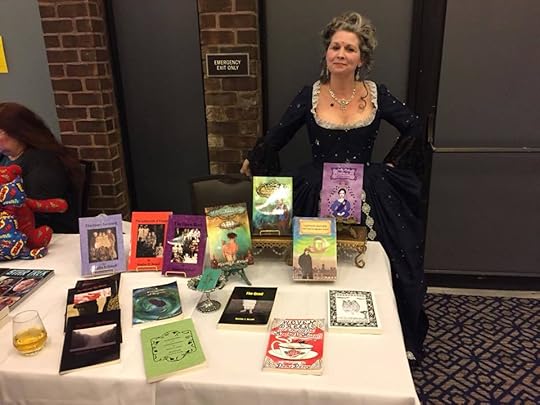
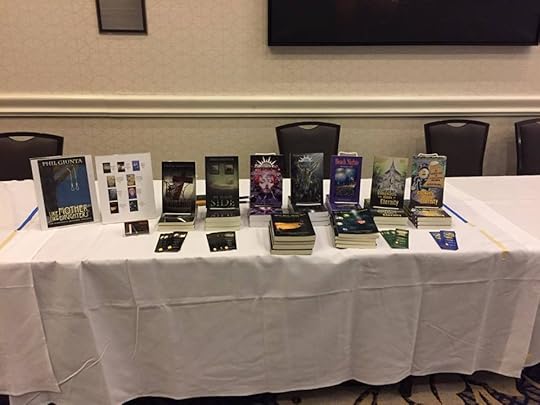
I actually set up at two different tables over the weekend. During the book fair (above) and on Saturday (below) where I spent about two hours at the assigned Firebringer Press table with my wife and long time convention pals Kathy and Kevin.
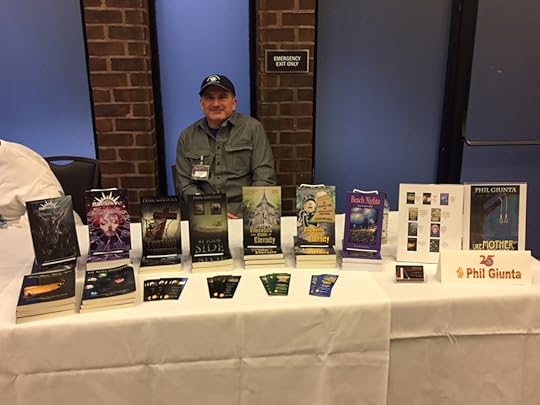
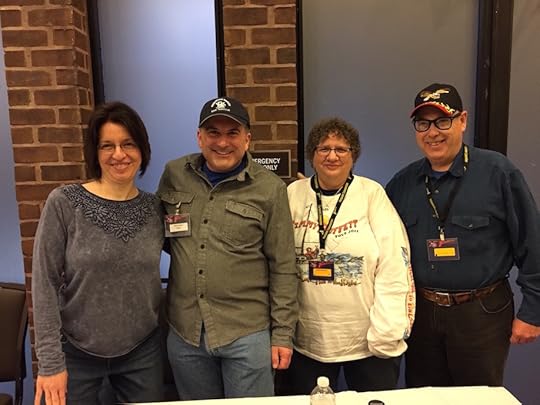 Evon, Phil, Kathy, Kevin at Farpoint 25 (Photo by Blair Learn)
Evon, Phil, Kathy, Kevin at Farpoint 25 (Photo by Blair Learn)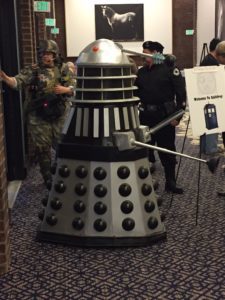 Of course, what SF convention would be complete without props and costumes! I’m sorry to say that while there were many fans in wonderful costumes during the convention (as always), I didn’t have an opportunity this time to take pictures. Worse, I did not feel well enough to attend the masquerade contest on Saturday night, but with credit to the photographers, here are a few of this year’s props and cosplayers…
Of course, what SF convention would be complete without props and costumes! I’m sorry to say that while there were many fans in wonderful costumes during the convention (as always), I didn’t have an opportunity this time to take pictures. Worse, I did not feel well enough to attend the masquerade contest on Saturday night, but with credit to the photographers, here are a few of this year’s props and cosplayers…
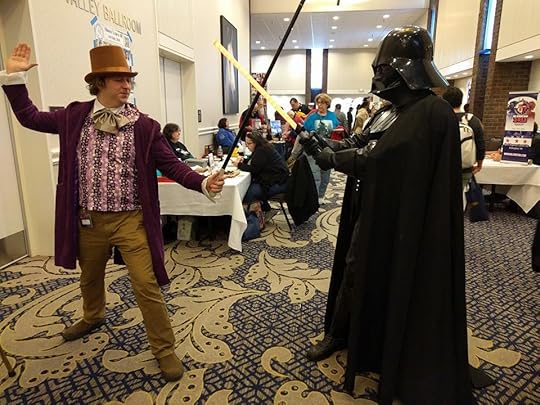 Willy Wonka vs. Darth Vader (Photo by Blair Learn)
Willy Wonka vs. Darth Vader (Photo by Blair Learn)Overall, my compliments to the Farpoint committee on a marvelous 25th anniversary celebration. Here’s to another 25 years!
February 7, 2018
Sketch Out the Scene, If You Know What I Mean…
There is no greater joy than the craft of writing, stepping outside your comfort zone, and experimenting with a new story. It’s one of the best ways to grow as a writer.
Working on this SF novel for the past two years (with stops and starts due to other writing projects and life’s demands) has been far more challenging than my previous two novels (both of which were paranormal mysteries).
What’s makes it challenging you ask? You probably didn’t ask, but I’ll tell you anyway—researching and staying true to science, keeping informed of advancements and theories in spacecraft propulsion, the latest exoplanet discoveries, and the changing landscape of space exploration (i.e. private companies like Space X taking over where NASA left off).
All of these come into play in my story. I’m on the first draft, working on what is, for now, chapter ten. The next scene I must write is an emotional goodbye between a husband and wife who, through events beyond their control, will never see each other again. The wife, a cosmologist and planetary scientist, is safely on Earth while her astronaut husband is about to die in space due to a catastrophe aboard his ship.
For this final conversation, I vacillated on which one should be the POV character. I pondered the scene for two days, until I had an epiphany this morning and identified the POV character (the husband). Over lunch, I sat down and quickly sketched out (blocked) the scene. Blocking requires minimal details, just a rough order of events and quick lines of dialogue that will all be fleshed out when you actually write the scene in your draft.
Some writers actually structure their blocking into categories (see March McCarron’s example here). For me, I already had the details of the setting, the situation, the tension, etc. I just needed to get my flowing thoughts on paper ASAP regarding the dialogue and the transition to the next scene.
After two handwritten pages of blocking, it all clicked perfectly. I jotted down several lines of dialogue that I had not thought of before—basically what their conversation will cover and the natural tension, fear, anxiety, and ultimate loss that will be imbued in their final words.
What’s more, I found a way to smoothly transition into the next scene where the husband and his pilot decide whether to die a slow death in space or go out in a blaze of glory. I don’t want to divulge details, of course, but sketching out a scene that I was not immediately certain how to approach was exceptionally helpful.
Even though I outline all of my stories before writing them, some scenes require a bit more thought and prep work than others. That’s where blocking can help provide direction, by allowing you to quickly experiment with a scene to find the best way to write it.
Here are some further resources about blocking scenes:
The Novel Writing Roadmap – Step 11: Blocking by the Novel Factory
Rough Out a Scene: Goals, DOs, DON’Ts, and the Writing by Darcy Pattison
Happy Writing!
February 2, 2018
Book Review: Fantastic Voyage by Isaac Asimov
After a scientist named Benes is successfully transported into the country from enemy territory, an assassination attempt leaves him with a dangerous and inoperable clot at the base of his brain.
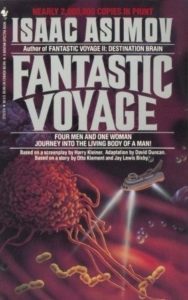 The situation falls under the jurisdiction of the CMDF (Combined Miniature Defense Force) run by General Alan Carter and Colonel Donald Reid. Once Benes is stabilized far underground in CMDF headquarters, a team is formed that will be miniaturized and injected into Benes’s bloodstream to destroy the clot from inside his body using a laser.
The situation falls under the jurisdiction of the CMDF (Combined Miniature Defense Force) run by General Alan Carter and Colonel Donald Reid. Once Benes is stabilized far underground in CMDF headquarters, a team is formed that will be miniaturized and injected into Benes’s bloodstream to destroy the clot from inside his body using a laser.
The team consists of civilian CMO Michaels, neurosurgeon Peter Duvall and his assistant Cora Peterson, special agent Charles Grant—who smuggled Benes into the country—and Captain William Owens, designer and pilot of the experimental submarine Proteus, which will carry the crew through Benes’s circulatory system. They are given one hour to complete the mission and exit Benes’s body before the miniaturization effect begins to reverse.
As if this were not dangerous enough, there is suspicion that one among the crew might be an agent for the Other Side, sent to kill Benes. Every setback and mishap causes yet another member of the team to come under scrutiny as precious time ticks away…
Contrary to popular belief, the classic film Fantastic Voyage was not based on the novel by Isaac Asimov. It’s the other way around. Otto Klement and Jay Lewis Bixby wrote the original story, which was adapted for the screen by Harry Kleiner and David Duncan. Asimov was hired on to write the novelization of the movie and he did a decent job with the material. While character development is non-existent (with the most interesting being Grant, Duvall, Michaels, and Peterson) the pacing is perfect and the challenges that plague our heroes at almost every turn maintain solid tension through to the end.
February 1, 2018
About This Writing Stuff…
February may be the shortest month of the year, but I managed to gather the largest collection of articles in quite some time on this blog. We begin with Margaret Atwood’s touching tribute to Ursula K. Le Guin.
Written Word Media offers ten publishing predictions in 2018 that are worth heeding and Writer Beware provides a comprehensive list of Author Solutions copycats.
Randy Ingermanson (aka “The Snowflake Guy”) gives us a lesson on Scene and Sequel. Lisa Cron encourages you to determine what your protagonist wants even before you start writing. Steven Pressfield reminds us that villains are not always people while Danielle Davis recommends (and I highly agree) that short stories provide an effective respite when you need a break from your novel.
All that and a lot more. Enjoy!
A Tribute to Ursula K. Le Guin by Margaret Atwood
Top Ten Publishing Trends Every Author Needs to Know in 2018 by Ricci
Writing the Perfect Scene by Randy Ingermanson
X-Ray for Authors: Tips and Tricks from Kindle Direct Publishing
The Strange Copyright of Doctor Who and The Shape of Non-Plagiarism by Jonathan Bailey
How To Write Memorable and Compelling Monologues by Ken Miyamoto
Army of Clones: Author Solutions Spawns a Legion of Copycats by Victoria Strauss for Writer Beware
Putting Conflict to Work in Your Stories, Part 1: Why Your Story Needs Conflict by Laura DiSilverio
Reboot Your Novel with the Short-Story Remedy by Danielle Davis
The Villain is Not Always a Person by Steven Pressfield
What Does Your Protagonist Want BEFORE the Story Starts? by Lisa Cron
Avoid Top 5 Writing Mistakes – Make Your Writing Better by AJ Humpage

